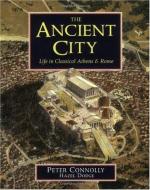|
This section contains 469 words (approx. 2 pages at 400 words per page) |

|
The Ancient City: Life in Classical Athens & Rome Summary & Study Guide Description
The Ancient City: Life in Classical Athens & Rome Summary & Study Guide includes comprehensive information and analysis to help you understand the book. This study guide contains the following sections:
This detailed literature summary also contains Topics for Discussion and a Free Quiz on The Ancient City: Life in Classical Athens & Rome by Peter Connolly.
The ancient cities of classical Athens and Rome are described and explored in the book, "The Ancient City, Life in Classical Athens and Rome." Although there is some mention of wars and conflicts and the defeat and victories of some of their rulers, the main emphasis of this book is daily living, the mores and laws of the time and the religious practices of the cultures. One of the major topics found in the sections about both cities, is the architectural design and constructions of buildings—from the simple homes of residents to the spectacular monuments and famous structures that are familiar to everyone worldwide.
The book begins with the golden years of Athens in the fifth century BC. A description of the battle to survive as a culture—their struggle to defend the city and provide adequate food and water to the large population of Athenians—begins the story of the classical culture. The infant democracy of the culture is described and defined as the cradle of democracy for the entire world. The daily life, occupations and religious practices are described in great detail. A section is devoted to the origin of the Olympic games that explains its initial religious connection. A large section is devoted to Greek theater, one of the greatest cultural gifts the Greeks give the rest of the world for all time to come. Athens loses prestige through the years but once Greek wins its independence in 1821, it becomes the capital city of Greece and returns to a city of prestige and importance.
Many of the subcategories in the section covering ancient Rome parallel those in the section about Athens. This section begins with the origin of Rome—its growth from a group of small settlements on the Tiber River to the great city it becomes. In fact, it ultimately became the center of the Great Roman Empire. There are subsections that cover its government, a form of democracy; the daily life of its residents—where they lived, what they ate, what they wore; the religious practices of Romans and the emergence of Christianity; and, Roman theater, how it was similar to Greek theater and how it differed. A large section is devoted to the building of the Colosseum and the gladiatorial games for which it was built. The construction of many of the other famous buildings and monuments in the city are also described in detail.
The last portion of this section describes the decrease in construction in Rome after the death of the emperor Hadrian. Emperors following him reduced their own powers, making way for a more democratic government. The emperor Constantine is credited with issuing a decree that recognizes Christianity as an acceptable religion and building the first Christian churches in Rome.
Read more from the Study Guide
|
This section contains 469 words (approx. 2 pages at 400 words per page) |

|



